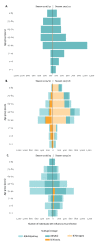Age-dependent influenza infection patterns and subtype circulation in Denmark, in seasons 2015/16 to 2021/22
- PMID: 38275020
- PMCID: PMC10986648
- DOI: 10.2807/1560-7917.ES.2024.29.4.2300263
Age-dependent influenza infection patterns and subtype circulation in Denmark, in seasons 2015/16 to 2021/22
Abstract
BackgroundInfluenza was almost absent for 2 years following the implementation of strict public health measures to prevent the spread of SARS-CoV-2. The consequence of this on infections in different age groups is not yet known.AimTo describe the age groups infected with the influenza virus in 2021/22, the first post-pandemic influenza season in Denmark, compared with the previous six seasons, and subtypes circulating therein.MethodsInfection and hospitalisation incidences per season and age group were estimated from data in Danish registries. Influenza virus subtypes and lineages were available from samples sent to the National Influenza Centre at Statens Serum Institut.ResultsTest incidence followed a similar pattern in all seasons, being highest in 0-1-year-olds and individuals over 75 years, and lowest in 7-14-year-olds and young people 15 years to late twenties. When the influenza A virus subtypes A(H3N2) and A(H1N1)pdm09 co-circulated in seasons 2015/16 and 2017/18 to 2019/20, the proportion of A(H1N1)pdm09 was higher in 0-1-year-olds and lower in the over 85-year-olds compared with the overall proportion of A(H1N1)pdm09 in these seasons. The proportion of A(H3N2) was higher in the over 85 years age group compared with the overall proportion of A(H3N2). The 2016/17 and 2021/22 seasons were dominated by A(H3N2) but differed in age-specific trends, with the over 85 years age group initiating the 2016/17 season, while the 2021/22 season was initiated by the 15-25-year-olds, followed by 7-14-year-olds.ConclusionThe 2021/22 influenza season had a different age distribution compared with pre-COVID-19 pandemic seasons.
Keywords: Influenza surveillance; age distribution; hospitalisation incidence; infection incidence; influenza subtypes and lineages.
Conflict of interest statement
Figures





References
-
- World Health Organization (WHO). Comparison of number of influenza detections by subtype. Geneva: WHO. [Accessed: 4 May 2023]. Available from: https://app.powerbi.com/view?r=eyJrIjoiZTIxMzAwMzYtZWE4NC00YTU2LWE3MTUtM...
-
- Emborg HD, Carnahan A, Bragstad K, Trebbien R, Brytting M, Hungnes O, et al. Abrupt termination of the 2019/20 influenza season following preventive measures against COVID-19 in Denmark, Norway and Sweden. Euro Surveill. 2021;26(22):2001160. 10.2807/1560-7917.ES.2021.26.22.2001160 - DOI - PMC - PubMed
-
- Emborg HD, Vestergaard LS, Botnen AB, Nielsen J, Krause TG, Trebbien R. A late sharp increase in influenza detections and low interim vaccine effectiveness against the circulating A(H3N2) strain, Denmark, 2021/22 influenza season up to 25 March 2022. Euro Surveill. 2022;27(15):2200278. 10.2807/1560-7917.ES.2022.27.15.2200278 - DOI - PMC - PubMed
MeSH terms
Substances
LinkOut - more resources
Full Text Sources
Medical
Miscellaneous
